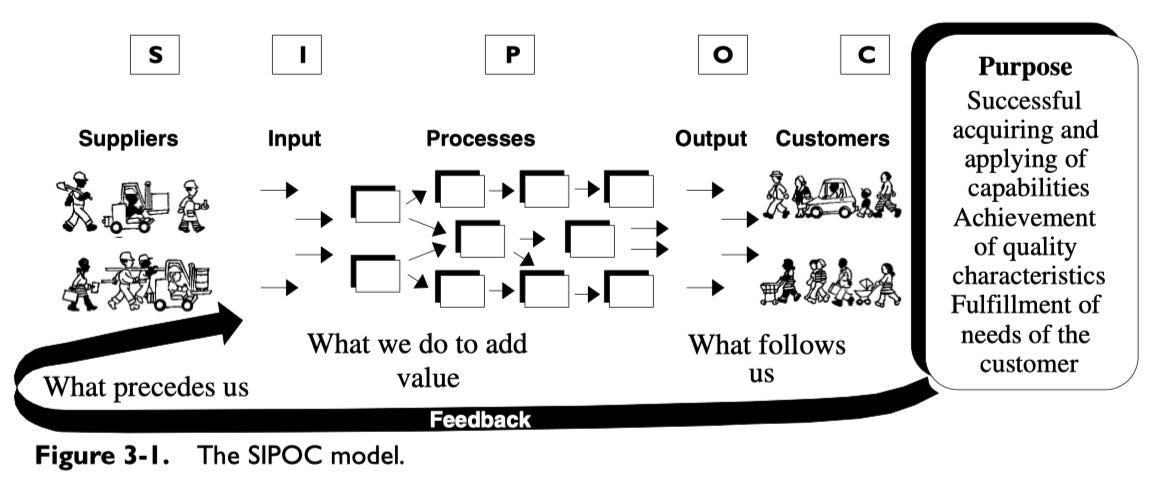What is My Job?
Whom Do I Depend On? Who Depends on Me?
The first step in any organization is to draw a flow diagram to show how each component depends on others. Then everyone may understand what his job is. If people do not see the process, they can not improve prove it. Anyone needs to see the process as a catwalk, walk, a flow diagram-Paul Batalden, M.D., 13 November 1990.
- Dr. W.E. Deming, The New Economics, 3rd ed., (p. 22)
Joy in work. Suppose we post names on Figure 6: you work here; John works there; I work here. Then everybody may see straightaway what is his job is - whom do I depend on, who depends on me. He may now engage his mind as well as his labor. He understands now what is meant by doing a good job. He may now take joy in his work.
This diagram, as an organization chart, is far more meaningful than the usual pyramid. The pyramid only shows responsibilities for reporting, who reports to whom. It shows the chain of command and accountability. A pyramid does not describe the system of production.
- Ibid., (p. 42)
One of the most influential innovations Dr. Deming introduced to the Japanese in 1950, and widely credited with igniting their quality revolution, was his view of production as a system. Visualized as a flow of activities and processes, the interdependence between components (people, materials, machines) becomes evident along with an appreciation of how localized improvements or changes in one place can affect the entire system’s performance.
In The Leader’s Handbook, Peter Scholtes introduces his own elaboration on Dr. Deming’s venerable diagram called the SIPOC Model. Like Deming, he saw this map as “an indispensable first step to understanding how the new philosophy applies to peoples’ daily work”. Note the emphasis on the Purpose of the system, which aligns with Deming’s definition of an aim that we discussed in an earlier post. Also observe the three categories he adds to clarify what is going on in the system: What precedes us, What we do to add value, and What follows us.
Scholtes provides this additional guidance to help broaden our thinking about our organization’s systems as not just an isolated instance defined by a single SIPOC, but an interdependent network:
Your job—and the jobs of all the people in your organization—consists of a collection of SIPOCs. Your work and theirs is part of a flow with steps that precede the work and steps that follow. To help you and your people begin to see work in its larger systemic context, you must see it as a SIPOC within larger SIPOCs within still larger SIPOCs.
- Peter Scholtes. The Leader’s Handbook. (p. 60).
Build Your Own SIPOC
For your homework, think about how to create your own high-level SIPOC or system diagram for your organization. Peter Scholtes suggests the following steps:
Describe the purpose of your organization by defining who you are and what you do.
What capabilities do you provide to your customers? What benefits do they accrue from interacting with you? What can they accomplish thanks to your efforts?
Work backward from your customer, and describe the outputs they receive that enable their capabilities, then the processes that create the outputs, and the inputs to the processes, and the suppliers or vendors you work with and what inputs they provide. Don’t worry about going into fine detail for now - start with broad brushstrokes, personalizing it by adding in names of people you know who depend on each other to make various parts of the system work. Share the diagram with a colleague and ask for their feedback. Do you have a shared understanding of who the customer is and the workflow that precedes their delivery of products and services? What changes should be made? What other SIPOCs can you identify for other dependent parts of the organization? How might using this diagram contribute to improving the work of people in the system so they can feel a greater sense of purpose or joy?
Extra Credit:
For those keen on seeing how visualizing and managing systems can lead to improvement, check out this talk by Louie Paynter at the 2012 Deming Institute Fall Conference where he outlines how his firm, Hallmark Building Supplies, applied Dr. Deming’s philosophy and teachings to improve their quality. There are some mind-blowing revelations here that show how far the ideas can be applied. And yes, they still proudly publish their business strategy and Purpose Document on their website to this very day.




